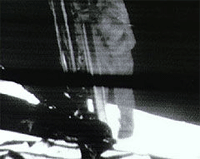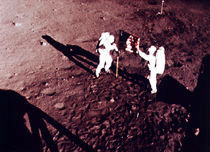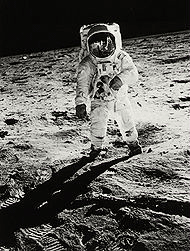
 |
| Neil Armstrong takes the first step onto the moon. (NASA) |
 |
| Armstrong and Buzz Aldrin planting an American flag on the moon's surface. (NASA) |
 |
| Aldrin posing for a photo. (NASA) |
The First Moonwalk
It is 9:30 p.m. Houston time on July 20, 1969. Armstrong and Aldrin put on their bulky moon suits and prepare to take the first steps on the moon.Armstrong is the first to wriggle out of a square hole in the Eagle. Once outside, he lowers a small drawbridge that holds a TV camera. Now the world can watch as he backs down the ladder.
Back on the home planet, 600 million people watch on television. Armstrong touches the moon's surface and says, "That's one small step for man… one giant leap for mankind."
Aldrin climbs out next. "Beautiful! Beautiful!" he says. "Magnificent desolation." He and Armstrong struggle to plant an American flag on the moon's surface. They get it standing, barely, and take pictures. President Nixon calls and congratulates them. Finally, they gather 50 pounds of rocks and set up experiments.
After about two hours, Aldrin and Armstrong crawl back into the Eagle. Both men have now been awake for 22 straight hours. They are supposed to rest before the complicated rendezvous with Collins, who is circling the moon every two hours. But they can't. There is little heat in the paper-thin LM, and they shiver with cold.
After less than a day on the lunar surface, it is time to go. Using its one small engine, the top part of the Eagle rises up. Dust blows everywhere. "I looked up long enough to see the flag fall over," Aldrin recalls.
Armstrong and Aldrin rendezvous with Collins in the Command Module. Once all three astronauts are back onboard Columbia, they release the Eagle. It falls away and crashes on the moon. Columbia then heads back towards Earth.



